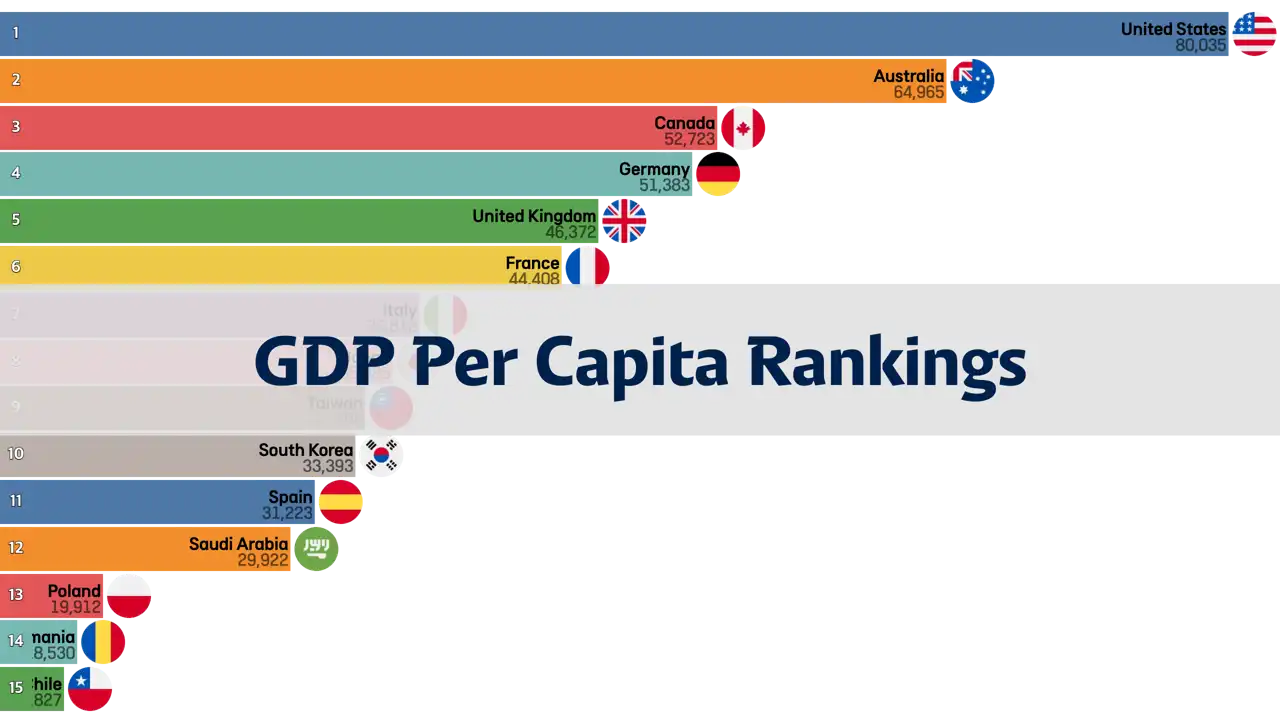
Ranking of GDP Per Capita for Countries with Populations Over 20 Million in 2023
- ASUMUP
- National Rankings
- August 10, 2024
When evaluating the economic strength of a country, one useful metric is GDP per capita, which represents the average economic output per person. In 2023, several countries with populations exceeding 20 million demonstrated significant economic performance, with their GDP per capita reflecting both their productivity and standard of living. This ranking offers insights into which nations lead the pack in terms of wealth per individual and what factors might contribute to these standings. Understanding this ranking can provide a clearer picture of global economic disparities and the economic well-being of large populations.
Top GDP Per Capita Rankings for Large Countries in 2023
- 1st United States - $80,034.7
- 2nd Australia - $64,965.4
- 3rd Canada - $52,722.8
- 4th Germany - $51,383.3
- 5th United Kingdom - $46,371.8
- 6th France - $44,408.3
- 7th Italy - $36,812.2
- 8th Japan - $35,385.2
- 9th Taiwan - $33,907.7
- 10th South Korea - $33,393.0
10th South Korea - $33,393.0
South Korea rounds out the top ten with a GDP per capita of approximately $33,393.0. South Korea's economy is one of the most advanced in Asia, with a strong emphasis on technology, manufacturing, and exports. The country is home to some of the world's largest and most successful companies in electronics, automotive, and shipbuilding industries.
The South Korean economy is supported by a highly educated workforce and a strong focus on research and development. Despite challenges such as an aging population and reliance on exports, South Korea continues to be a major player in the global economy, known for its innovation and industrial strength.
9th Taiwan - $33,907.7
Taiwan ranks 9th with a GDP per capita of about $33,907.7. Taiwan's economy is heavily export-oriented, with significant contributions from the technology and electronics sectors. The country is a leading global supplier of semiconductors, which are critical to numerous industries worldwide.
In addition to its technology sector, Taiwan has a strong manufacturing base and a dynamic service sector. The country's economic growth is supported by a well-educated workforce and a strong emphasis on innovation. Despite geopolitical tensions and reliance on exports, Taiwan has managed to build a resilient and competitive economy.
8th Japan - $35,385.2
Japan holds the 8th position with a GDP per capita of approximately $35,385.2. Japan's economy is the third-largest in the world and is driven by its advanced technology, manufacturing, and export sectors. Key industries include automotive, electronics, and robotics, where Japan remains a global leader.
Japan's economic strength is also supported by its high level of innovation and a strong work ethic within its population. However, the country faces significant challenges such as an aging population and a declining workforce, which put pressure on its economic sustainability. Despite these issues, Japan continues to maintain a strong economic presence globally.
7th Italy - $36,812.2
Italy ranks 7th with a GDP per capita of around $36,812.2. Italy’s economy is well known for its manufacturing sector, particularly in fashion, automotive, and industrial machinery. Small and medium-sized enterprises (SMEs) play a significant role in the Italian economy, contributing to both domestic and export markets.
Despite facing challenges such as political instability and a high level of public debt, Italy’s economy benefits from its rich cultural heritage and a strong tourism sector. The country's high-quality craftsmanship and global reputation for design continue to drive economic activity, especially in export-oriented industries.
6th France - $44,408.3
France takes the 6th spot with a GDP per capita of approximately $44,408.3. The French economy is diverse, with key contributions from industries such as aerospace, automotive, luxury goods, and agriculture. France is also a global leader in tourism, with Paris being one of the most visited cities in the world.
In addition to its industrial and cultural strengths, France has a well-developed welfare system and public services, which support a high standard of living. While facing economic challenges such as high public debt and unemployment, France continues to be one of the leading economies in Europe, known for its innovation and influence in global affairs.
5th United Kingdom - $46,371.8
The United Kingdom ranks 5th with a GDP per capita of around $46,371.8. The UK economy is highly diversified, with key sectors including finance, healthcare, technology, and creative industries. London, as a global financial center, plays a significant role in the country's economic output, attracting investment and talent from around the world.
Despite the economic uncertainties brought by Brexit and the challenges of navigating a post-EU trade landscape, the UK has maintained its economic standing through strong domestic consumption and an adaptive service sector. The UK's position in this ranking highlights its resilience and the continued importance of its global economic connections.
4th Germany - $51,383.3
Germany holds the 4th position with a GDP per capita of about $51,383.3, reflecting its role as Europe's largest economy. Germany's economic strength is largely driven by its manufacturing sector, particularly in automobiles, machinery, and chemicals. The country is known for its engineering expertise and high-quality products, which are in demand globally.
In addition to manufacturing, Germany has a robust service sector and is a leader in technological innovation and green energy. The country’s strong educational system and well-developed infrastructure also contribute to its high economic output. Despite challenges such as an aging population and economic pressures within the Eurozone, Germany continues to maintain a strong economic position.
3rd Canada - $52,722.8
Canada comes in third with a GDP per capita of approximately $52,722.8. Canada's economy is characterized by its richness in natural resources, particularly in energy, mining, and forestry. These sectors, combined with a highly developed service sector, including finance, healthcare, and education, contribute to the country’s overall economic output.
Canada also benefits from strong trade relations, particularly with the United States, its largest trading partner. The country's emphasis on immigration and multiculturalism has also played a role in sustaining economic growth, as a diverse workforce supports various industries. Canada's position in the ranking reflects its balanced economy and high quality of life.
2nd Australia - $64,965.4
Australia ranks second with a GDP per capita of around $64,965.4, underscoring its status as one of the world's most prosperous nations. The Australian economy benefits from abundant natural resources, particularly in mining and energy, which are major exports. In addition to its resource wealth, Australia has a strong service sector, including finance, education, and tourism, which contributes significantly to its GDP.
The country's stable political environment, well-developed infrastructure, and high quality of life make it an attractive destination for skilled workers and immigrants, further boosting its economic performance. Australia's position in this ranking highlights its ability to maintain a high standard of living for its population of over 25 million people.
1st United States - $80,034.7
The United States stands at the top of the list with an impressive GDP per capita of approximately $80,034.7. This high figure is reflective of the country's diversified economy, which is bolstered by strong sectors such as technology, finance, and healthcare. The U.S. benefits from a large domestic market, a well-developed infrastructure, and a culture of innovation and entrepreneurship that drives growth across multiple industries.
Despite economic challenges such as income inequality and rising costs of living, the overall economic environment in the U.S. remains strong, supported by robust consumer spending and significant investment in both public and private sectors. This places the United States well ahead of other large countries in terms of per capita wealth, showcasing its position as a global economic leader.
Other Posts in the National Rankings
Categories
- National Rankings(43)
- Science & Technology(1)
- Sports(24)
- Economy(30)
- Society(12)
- Culture(7)
Recent Posts
![Bayern Spent HOW MUCH on Harry Kane?! Ranking Their Top 10 Biggest Signings Ever]() A deep dive into Bayern Munich's ten most expensive transfers, exploring how the club's spending strategy has evolved to chase European glory.
A deep dive into Bayern Munich's ten most expensive transfers, exploring how the club's spending strategy has evolved to chase European glory.![Arsenal's Record-Shattering Spree: From a €116M Gamble to a Flop, Who Was Worth the Cash?]() A deep dive into Arsenal's top 10 most expensive signings, analyzing the successes, the failures, and the massive fees that have defined the club's modern transfer strategy.
A deep dive into Arsenal's top 10 most expensive signings, analyzing the successes, the failures, and the massive fees that have defined the club's modern transfer strategy.![Chelsea Cashes In BIG TIME! Who Really Won the 25/26 Summer Transfer Window Money Game?]() A deep dive into the top 10 clubs that made the most money from player sales during the wild 25/26 summer transfer window.
A deep dive into the top 10 clubs that made the most money from player sales during the wild 25/26 summer transfer window.![Liverpool's Record-Breaking €483M Spree! Did They Just Buy the Premier League Title?]() A deep dive into the 25/26 summer transfer window reveals Liverpool's record-breaking spending spree as Premier League clubs continue to dominate the market.
A deep dive into the 25/26 summer transfer window reveals Liverpool's record-breaking spending spree as Premier League clubs continue to dominate the market.![You Won't Believe How Much a Loaf of Bread Costs in These Countries! (Spoiler: It's INSANE)]() This post explores the top 10 countries with the most expensive bread, revealing how factors like import reliance and tourism dramatically inflate the cost of this basic staple.
This post explores the top 10 countries with the most expensive bread, revealing how factors like import reliance and tourism dramatically inflate the cost of this basic staple.
















